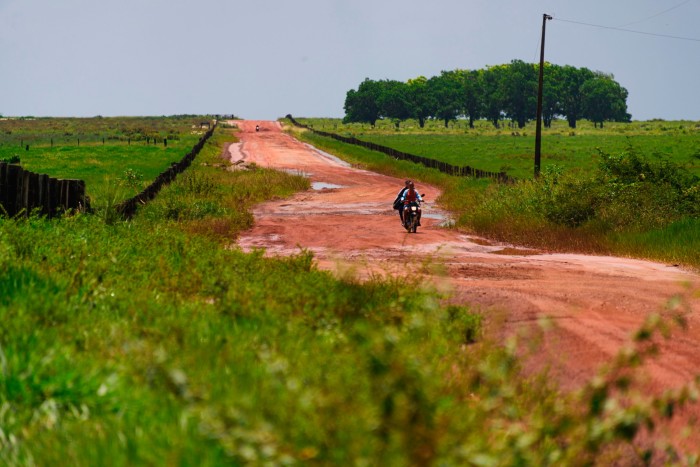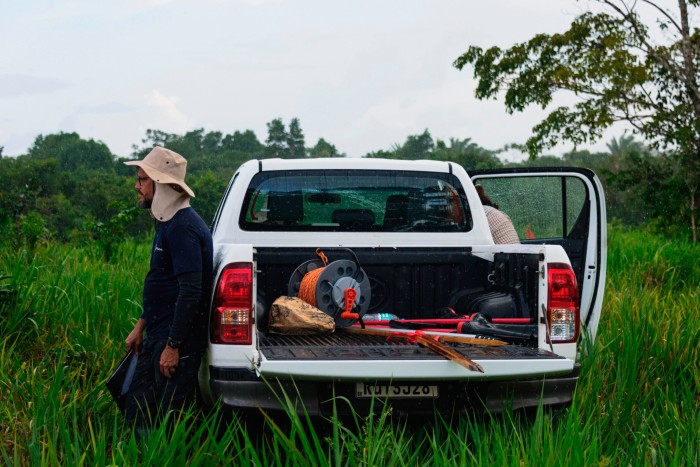[ad_1]
Standing in front of a vast stretch of Amazonian grassland, the forest visible only on the horizon, Renato Crouzeilles and his team attract curious looks from a trickle of passers-by, unaccustomed to seeing strangers in such a remote corner of Brazil.
As director of science at Mombak, a two-year-old reforestation start-up, Crouzeilles is planting 3mn trees across almost 3,000 hectares in the country’s Pará state, in one of the largest such projects aimed at restoring forest in the Amazon biome.
“The biggest challenge in the region is to change the culture. It is not a forest culture, they don’t think about reforestation. What they did in the past was to deforest and then put cows here,” he said.
The Amazonian rainforest absorbs vast amounts of carbon and is a crucial buffer against climate change. But the region has been ravaged by deforestation linked to illegal cattle ranching, gold mining and timber exports. Last year, forested land equivalent in size to 3,000 football pitches was razed every day, according to non-profit environmental group Imazon, with the then-government led by rightwing populist Jair Bolsonaro accused of turning a blind eye.
But with the election in October of President Luiz Inácio Lula da Silva, who has pledged to end illegal deforestation, environmental protection is again centre stage.
While government efforts have so far focused on bolstering enforcement to prevent the destruction, a series of private companies are working on reforestation. They purchase or lease land, plant trees and generate revenue by selling carbon credits, which buyers use to compensate for pollution produced by their activities. Each offset represents a tonne of emissions avoided or removed from the atmosphere.

At about 400mn hectares, Brazil’s section of the Amazon rainforest represents the world’s largest opportunity for reforestation. More than 54mn square hectares of the biome — an area 1.3 times the size of California — is pastureland, which is suitable for planting trees.
“Reforestation of tropical forests could make an important contribution to alleviating . . . [global emissions] and the Brazilian Amazon is the largest tropical forest on the planet,” said José Scheinkman, a professor of economics at Columbia University and a member of the Amazon 2030 project, a Brazilian initiative to sustainably develop the rainforest.
According to scientists at Project Drawdown, a US-based non-profit organisation that advises on greenhouse gas reduction, reforestation of tropical and temperate forests could remove up to 113 gigatonnes of carbon from the atmosphere between now and 2050.
This is more than twice the potential of silvopasture — the integration of trees with livestock — which is considered the next most effective method, according to Project Drawdown. Global carbon emissions reached almost 38 gigatonnes in 2021, according to international database EDGAR.

Pedro Brancalion, a reforestation specialist at the University of São Paulo, said creating and maintaining forests could bring global, regional and local benefits, including mitigating climate change, protecting the air currents known as “flying rivers” that carry water from the Amazon across Latin America, supporting agriculture and industry. Locally, it can create jobs and generate income from carbon credits and forestry products.
But reforestation initiatives in Brazil have been beset by difficulties, notably the complexity of land rights and ownership claims, said Brancalion.

Verra, a US-based carbon credits standards body, said it had received numerous allegations of aggressive behaviour by reforestation project developers related to land ownership, but added it had so far found no evidence of wrongdoing.
“Land is the number one issue, specifically finding land that has full legal titles,” said Peter Fernández, chief executive and co-founder of São Paulo-based Mombak.
“There is more than enough land to be used. However, finding it and evaluating that it is [legally compliant] takes a lot of effort,” he said. Mombak did not buy smallholder land or land near indigenous areas to avoid disputes, he added.
Fernández said the company planned to expand its project to 50,000 hectares with the goal of removing 1mn tonnes of carbon from the atmosphere each year by 2030: “We need to create a reforestation industry that is at the scale of the pulp and paper industry. This is not artisanal. This is not an NGO job.”

One bottleneck is a shortage of tree seeds. But a broader concern is the credibility of the carbon credits market, which underpins the reforestation business model. Mombak initially received venture capital funding before securing a $100mn investment from Bain Capital and intends to generate revenue by selling the credits.
But the market has long attracted controversy, with critics saying projects do not always deliver the promised environmental benefits. They say that some credits cost less than $5 each, which does little to give incentives to companies to reduce pollution, and that it can be difficult to distinguish between high and low quality credits in what is an unregulated and often opaque market.
But Fernández said the market was necessary and if it did not scale up, efforts to remove carbon would likewise not increase, “which means the world will heat up. It’s just that simple.”

Reform efforts are under way. The Integrity Council for the Voluntary Carbon Market, an international task force initially spearheaded by former Bank of England governor Mark Carney, is this year expected to announce a set of rules for what a “good” market looks like.
Another concern is ensuring that reforested areas are permanent and carbon is not re-released into the atmosphere. Richard Kelly, co-head of Foresight Sustainable Forestry Company, which is developing carbon credit projects in the UK, said keeping the forests healthy and protecting them from fire — an increasing risk as climate change intensifies — was a challenge.
Meanwhile, clad in shin guards to protect from snakes and wide-brimmed hats to stave off the sun, Crouzeilles and his team traverse the Pará site in pick-up trucks.
The region was chosen carefully, Crouzeilles said. One factor was that “there is a lower risk of fire here [because of regular rainfall]. It is a region facing lower climate change risk.”
Despite lack of awareness about reforestation in an impoverished area focused on cattle-rearing, Crouzeilles said his team had been warmly welcomed by locals, who were eager to know about jobs with the project.
“It is a process to change minds and cultures,” he said. “But fortunately we are being very well received.”
Additional reporting by Carolina Ingizza
[ad_2]
Source link
